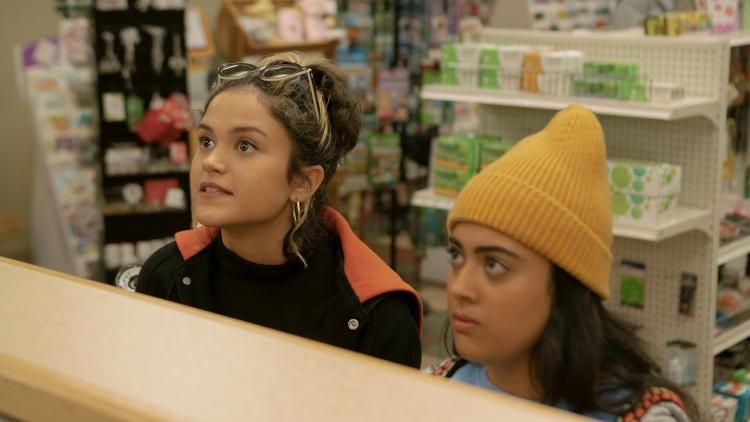Queer, POC Youth Rule in New Teen Flicks Like ‘Plan B’
Author: John Casey

“You see us as you want to see us: in the simplest terms, the most convenient definitions. You see us as a Brain, an Athlete, a Basketcase, Princess, and a Criminal. Correct?”
If you came of age during the 1980s, and even the 1990s, these words should ring familiar to you. They are part of the legendary letter, written by Brian, Anthony Michael Hall’s character, in the momentous teen rite of passage film The Breakfast Club.
I still watch that film, and many of you probably do too. It takes you back to a time, a place, and an age of coming into your own as a young adult. Yet, looking back on films like The Breakfast Club now, the definitions of the characters, or caricatures, are indeed drawn in the simplest of terms.
To be sure, in 1985, when the film first came out, if you were in high school, you were loath to come out. So, Brian in his letter would certainly not mention a gay student, or a lesbian, or a queer peer. Being labeled with any of those terms would most assuredly not even gain you admittance to the morning “detentionites” of The Breakfast Club.
Even more striking, there are virtually no persons of color in mainstream teen movies of the 1980s or 1990s. The Breakfast Club is as white bread as it gets. So for me, the film actually depicted where I grew up and went to school; in an overwhelming white enclave. I often wonder, if there were a Black student, or a gay student, what affect that would have had on my affinity for the film. Would it have broadened my perspective?
Coming-of-age teen films have proliferated and changed since the years of John Hughes trademark, cookie-cutter young adult films. Gradually, gay students became a part of the stories, and so did more racially diverse casts. And the subject matter dove into more contemporary issues. However Brian getting detention in The Breakfast Club for having a gun in his locker was an ominous harbinger to the rise of violent school shootings.
Hulu’s current summer hit, the coming-of-age film Plan B is consequential in its own right for taking on subjects and nationalities often ignored or left behind. It’s a modern-day rite of passage movie that includes Native American and Hispanic actresses as leads. The film, through comedy and some high-stakes drama, deals with the morning-after pill, depicts the coming out process, touches on drug use, portrays a teen with a Prince Albert piercing, and takes place in a very remote area of the country, the Dakotas and Iowa.
Plan B literally flips the script on the standard teen films and the caricatures they come with, and it does so in a way that is highly entertaining without being threatening.
Without spoiling the plot, Plan B follows BFFs Sunny (Kuhoo Verma) and Lupe (Victoria Moroles) on a crazy road trip to find a Planned Parenthood clinic, which is miles and miles away from their home (a subtle point in the movie about the lack of access in rural areas to Planned Parenthood). During the trip, Lupe comes out to a surprised Sunny. I won’t spoil the plot further, but it’s uproariously funny.
I had the opportunity to speak with Moroles, who plays the Thelma to Verma’s Louise. In her life, Moroles is straight but a solid queer ally. We discussed the meaning and uniqueness of the film, and how it is representative of the 21st-century teen tale.
First, what did this film mean to Moroles, especially when she saw the script for the first time? “There was a tremendous amount of emotions, but mainly so much excitement,” Moroles recalled. “When I read the script, I was thrilled. I’m a huge fan of buddy comedies, but this film went a step further since the main messages are about inclusion and representation. It was a dream come true.”
Moroles explained that the wild character (and that’s an understatement) of Lupe was initially formed over time, not only during the rigorous audition process, but after Moroles getting the part, with lots of script changes during rehearsals and shooting. “I kind of got to see her evolve into a really strong character. It was a really beautiful process during three weeks of a lot of work on it. And, I strongly support who she is, where Lupe’s coming from, and all she represents.”
I asked Moroles if there were any similarities between her and the character of Lupe. “It’s not often that I connect like I did with this character. Her sense of reflection, and the way she uses her humor, and the way she goes about her life with purpose, and even the way she moves her body. There’s a lot of me in Lupe, and that makes me so proud.”
How proud was Moroles to be involved with a story that featured two teens of color as the leads, subjects like the morning-after pill, and being a queer teen? “There was so much freedom in this film, and that was incredibly important and meaningful to me. We held Lupe’s story up with a lot of grace.”
“Luckily now, we see queer stories told so many times, so it was important to give her that freedom of being able to explore her sexuality at 17, and as a member of the Latino community. I just hope it helps other queer Latinos who struggle with their own sexuality, and are afraid to be themselves because, like Lupe, they live in very religious, traditional households.”
Moroles said the goal was to normalize Lupe’s sexuality in addition to the other subjects that the film covers. “While it’s hilarious, and Lupe and Sunny go through crazy obstacles, it most likely mirrors, or is a reflection, of what some teens girls go through in middle America. The contraception part was touchy and difficult to navigate; however, hopefully it raises some awareness about the lack of access to reproductive health care for many in the U.S.”
Moroles admitted to being a fan of the John Hughes teen classics, particularly Pretty in Pink. “I’ve watched that movie so many times. I was super obsessed, but it’s clear that the tone and make up of these films have really changed. Having one told by non-whites, like Plan B is huge and would have meant so much to me growing up.”
How has the reaction been so far to the film? The critics have raved about it, and it’s been a hit on Hulu. Is Lupe’s character resonating? “It’s been great. I’m so happy that people are able to enjoy it and connect with it, particularly the queerness of Lupe.”
“The messages and comments on social media have been so positive. I’m also excited for all my friends in the cast. We all became close. There were so many firsts in this film. I just hope that future generations of teens and those in their early 20 are equally moved by Lupe and Sunny’s amazing adventure, and that the teachable moments in the film last a long time.”
John Casey is editor at large for The Advocate.
Original Article on The Advocate
Author: John Casey



